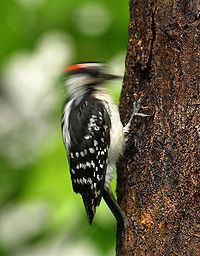Woodpecker
 From Conservapedia
From Conservapedia | Woodpecker | |
|---|---|

| |
| Hairy Woodpecker, Dendrocopos villosus | |
| Scientific classification | |
| Kingdom Information | |
| Domain | Eukaryota |
| Kingdom | Animalia |
| Subkingdom | Bilateria |
| Branch | Deuterostomia |
| Phylum Information | |
| Phylum | Chordata |
| Sub-phylum | Vertebrata |
| Infraphylum | Gnathostomata |
| Class Information | |
| Superclass | Tetrapoda |
| Class | Sauropsida |
| Sub-class | Avialae |
| Infra-class | Aves |
| Order Information | |
| Superorder | Passerimorphae |
| Order | Piciformes |
| Sub-order | Pici |
| Infraorder | Picides |
| Family Information | |
| Superfamily | Picoidea |
| Family | Picidae |
| Sub-family | Picinae |
| Population statistics | |
Woodpeckers consist of 180 species of tree-clinging birds of the family Picidae, characterized by the use of their beaks as a hammer on trees,[1] either probing for food or chiseling out cavities to make nests. With the exception of Australia and New Guinea, woodpeckers are found world-wide, with twenty-one species in the United States.[2]
Contents
- 1 Description
- 2 Evidence against Evolution
- 3 References
- 4 External links
Description[edit]
Woodpeckers vary in size from three inches in the piculets (Picumnus sp.) of South America to twenty-four inches for the (possibly extinct) imperial woodpecker (Campephilus imperialis) of Mexico. All bear "zygodactyl" feet - two toes in front, two behind - as an aid in clinging to tree bark; in addition, stiffened tail feathers on most species help to prop the bird in a tripod stance when clinging vertically.
Woodpeckers are generally colored dark above, with light underbellies. Sexual dimorphism is present, with males displaying distinctive colors and patterns versus females. Most species feed on insects; some feed on fruits, and a few feed on the sap of trees. All woodpeckers have a long, sticky tongue, which is used to gather insects or sap after drilling into trees.
Evidence against Evolution[edit]
The skull of the woodpecker is uniquely suited to absorb the intense shocks generated by its feeding habits.[3] If the skull was weaker at some point in the past, the bird would not have been able to feed in such a manner. But if the bird didn't feed in such a manner, then what would have been the reason for it to evolve a thicker skull? Evolutionists have not been able to produce an answer to this question.
References[edit]
- ↑ http://www.defenders.org/wildlife_and_habitat/wildlife/woodpeckers.php
- ↑ Internet Center for Wildlife Damage Management, WOODPECKERS, by Rex E. Marsh, 2005 [1]
- ↑ https://blogs.wsj.com/ideas-market/2011/02/18/woodpecker-skulls-ultimate-shock-absorbers/
External links[edit]
- http://creagrus.home.montereybay.com/woodpeckers.html
Categories: [Birds]
↧ Download as ZWI file | Last modified: 03/10/2023 12:49:30 | 24 views
☰ Source: https://www.conservapedia.com/Woodpecker | License: CC BY-SA 3.0
 ZWI signed:
ZWI signed: KSF
KSF